Project Management Plan for ADD Tender: MANU2123, Semester 2, 2018
VerifiedAdded on 2022/12/22
|18
|5592
|2
Project
AI Summary
This project management plan (PMP) outlines a comprehensive approach to managing the Australian Antarctic Division (ADD) tender for the provision of food, household, and cleaning products and services. The plan encompasses the project scope, timeline, budget, human resource management, quality control, and risk management. It details the project's introduction, scope of work, timeline, assumptions, and limitations. The plan also addresses scheduling and time management, milestones, cost and budget management, human resource management, project quality management, and communication strategies. The project review process, PMIS implementation, and lessons learned are also thoroughly discussed. The assignment emphasizes the importance of a well-defined project management plan for successful project execution, including the establishment of communication channels, stakeholder management, and risk mitigation strategies. The plan also highlights the importance of addressing issues related to food supply, logistics, and environmental considerations in the Antarctic region.

Project Management Plan
Subject Name and Code:
Module Name and Code:
Lecturer:
Student Name and Number:
Date:
Subject Name and Code:
Module Name and Code:
Lecturer:
Student Name and Number:
Date:
Paraphrase This Document
Need a fresh take? Get an instant paraphrase of this document with our AI Paraphraser
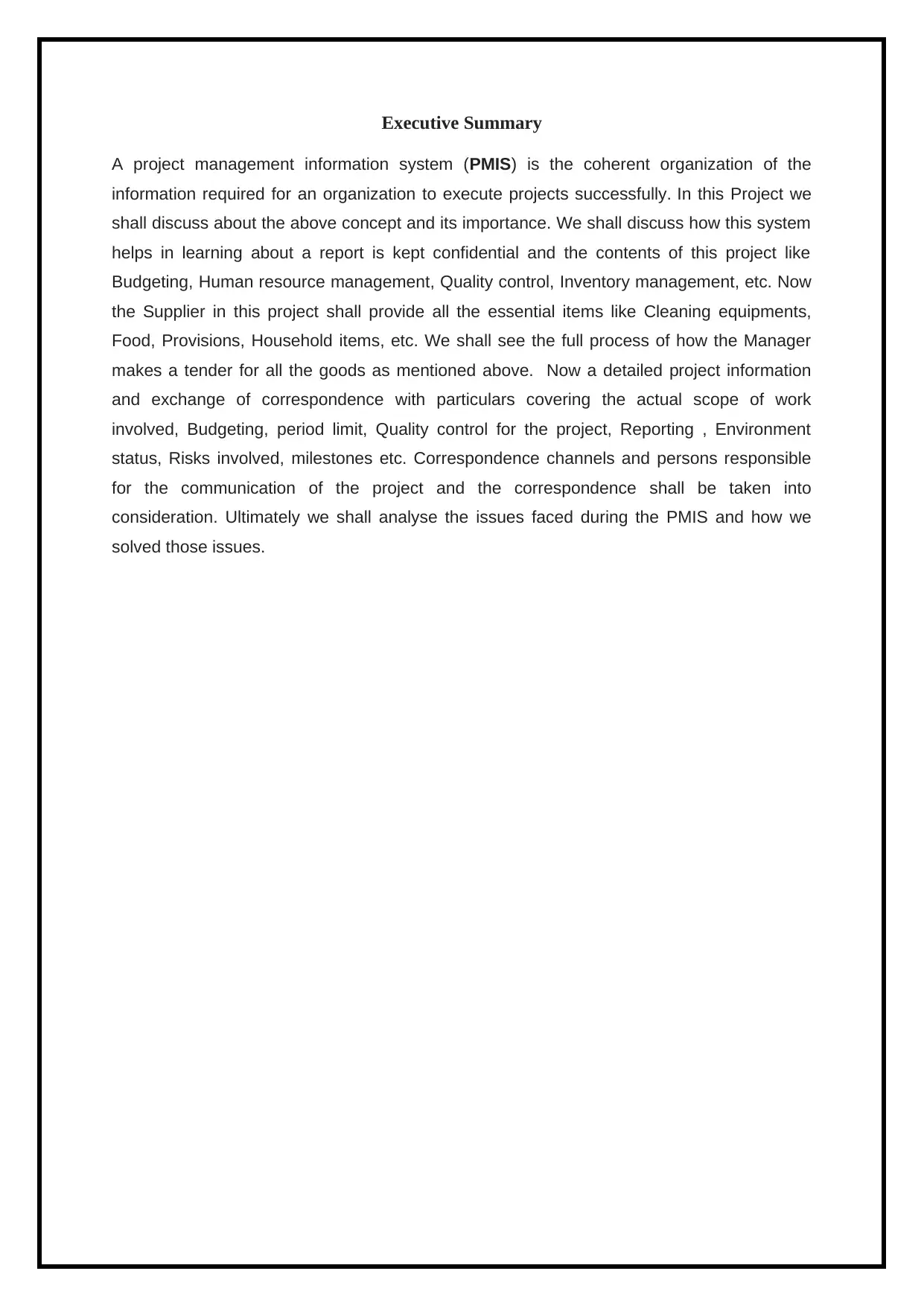
Executive Summary
A project management information system (PMIS) is the coherent organization of the
information required for an organization to execute projects successfully. In this Project we
shall discuss about the above concept and its importance. We shall discuss how this system
helps in learning about a report is kept confidential and the contents of this project like
Budgeting, Human resource management, Quality control, Inventory management, etc. Now
the Supplier in this project shall provide all the essential items like Cleaning equipments,
Food, Provisions, Household items, etc. We shall see the full process of how the Manager
makes a tender for all the goods as mentioned above. Now a detailed project information
and exchange of correspondence with particulars covering the actual scope of work
involved, Budgeting, period limit, Quality control for the project, Reporting , Environment
status, Risks involved, milestones etc. Correspondence channels and persons responsible
for the communication of the project and the correspondence shall be taken into
consideration. Ultimately we shall analyse the issues faced during the PMIS and how we
solved those issues.
A project management information system (PMIS) is the coherent organization of the
information required for an organization to execute projects successfully. In this Project we
shall discuss about the above concept and its importance. We shall discuss how this system
helps in learning about a report is kept confidential and the contents of this project like
Budgeting, Human resource management, Quality control, Inventory management, etc. Now
the Supplier in this project shall provide all the essential items like Cleaning equipments,
Food, Provisions, Household items, etc. We shall see the full process of how the Manager
makes a tender for all the goods as mentioned above. Now a detailed project information
and exchange of correspondence with particulars covering the actual scope of work
involved, Budgeting, period limit, Quality control for the project, Reporting , Environment
status, Risks involved, milestones etc. Correspondence channels and persons responsible
for the communication of the project and the correspondence shall be taken into
consideration. Ultimately we shall analyse the issues faced during the PMIS and how we
solved those issues.
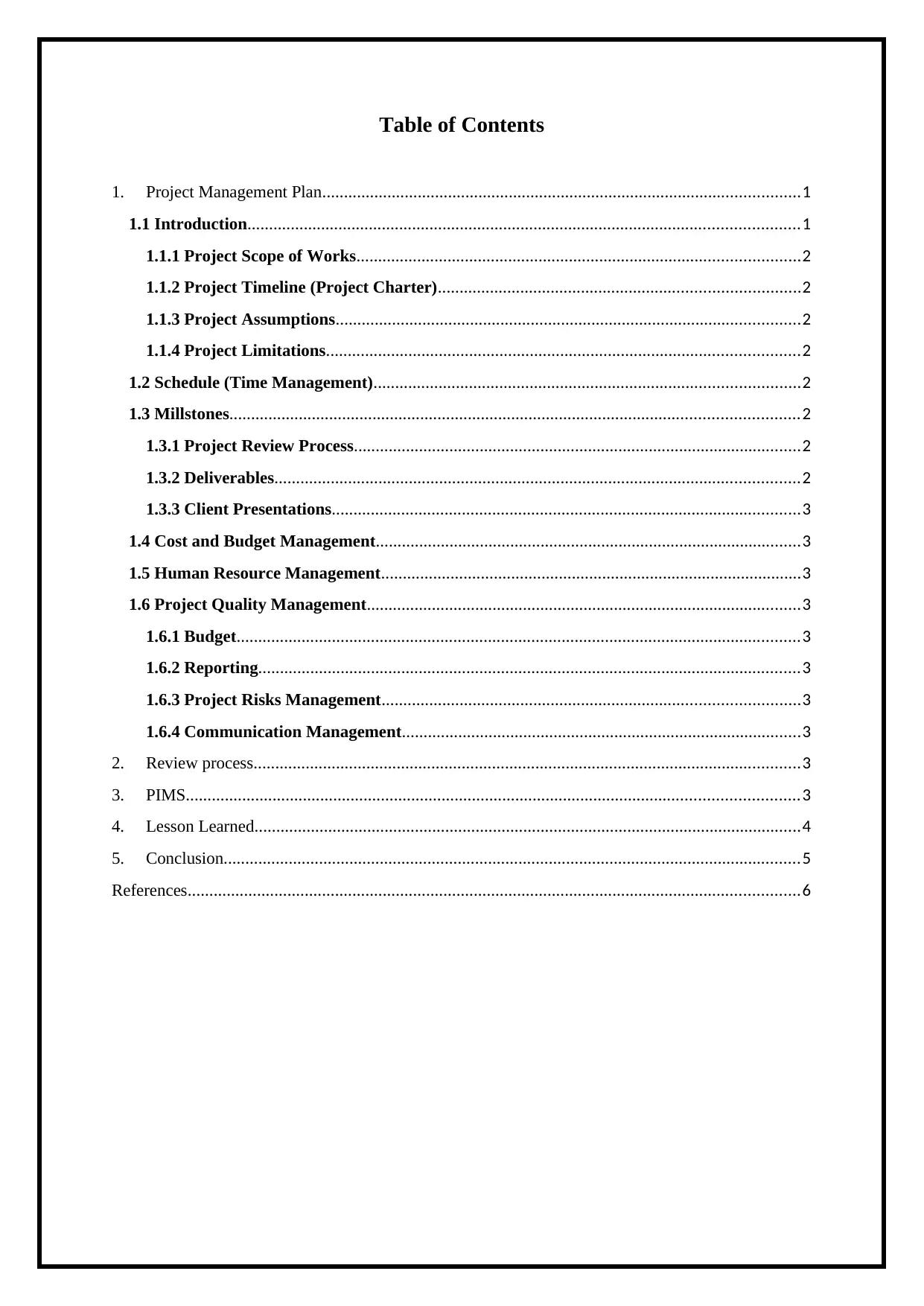
Table of Contents
1. Project Management Plan..............................................................................................................1
1.1 Introduction...............................................................................................................................1
1.1.1 Project Scope of Works......................................................................................................2
1.1.2 Project Timeline (Project Charter)...................................................................................2
1.1.3 Project Assumptions...........................................................................................................2
1.1.4 Project Limitations.............................................................................................................2
1.2 Schedule (Time Management)..................................................................................................2
1.3 Millstones...................................................................................................................................2
1.3.1 Project Review Process.......................................................................................................2
1.3.2 Deliverables.........................................................................................................................2
1.3.3 Client Presentations............................................................................................................3
1.4 Cost and Budget Management..................................................................................................3
1.5 Human Resource Management.................................................................................................3
1.6 Project Quality Management....................................................................................................3
1.6.1 Budget..................................................................................................................................3
1.6.2 Reporting.............................................................................................................................3
1.6.3 Project Risks Management................................................................................................3
1.6.4 Communication Management............................................................................................3
2. Review process..............................................................................................................................3
3. PIMS.............................................................................................................................................3
4. Lesson Learned..............................................................................................................................4
5. Conclusion.....................................................................................................................................5
References.............................................................................................................................................6
1. Project Management Plan..............................................................................................................1
1.1 Introduction...............................................................................................................................1
1.1.1 Project Scope of Works......................................................................................................2
1.1.2 Project Timeline (Project Charter)...................................................................................2
1.1.3 Project Assumptions...........................................................................................................2
1.1.4 Project Limitations.............................................................................................................2
1.2 Schedule (Time Management)..................................................................................................2
1.3 Millstones...................................................................................................................................2
1.3.1 Project Review Process.......................................................................................................2
1.3.2 Deliverables.........................................................................................................................2
1.3.3 Client Presentations............................................................................................................3
1.4 Cost and Budget Management..................................................................................................3
1.5 Human Resource Management.................................................................................................3
1.6 Project Quality Management....................................................................................................3
1.6.1 Budget..................................................................................................................................3
1.6.2 Reporting.............................................................................................................................3
1.6.3 Project Risks Management................................................................................................3
1.6.4 Communication Management............................................................................................3
2. Review process..............................................................................................................................3
3. PIMS.............................................................................................................................................3
4. Lesson Learned..............................................................................................................................4
5. Conclusion.....................................................................................................................................5
References.............................................................................................................................................6
⊘ This is a preview!⊘
Do you want full access?
Subscribe today to unlock all pages.

Trusted by 1+ million students worldwide
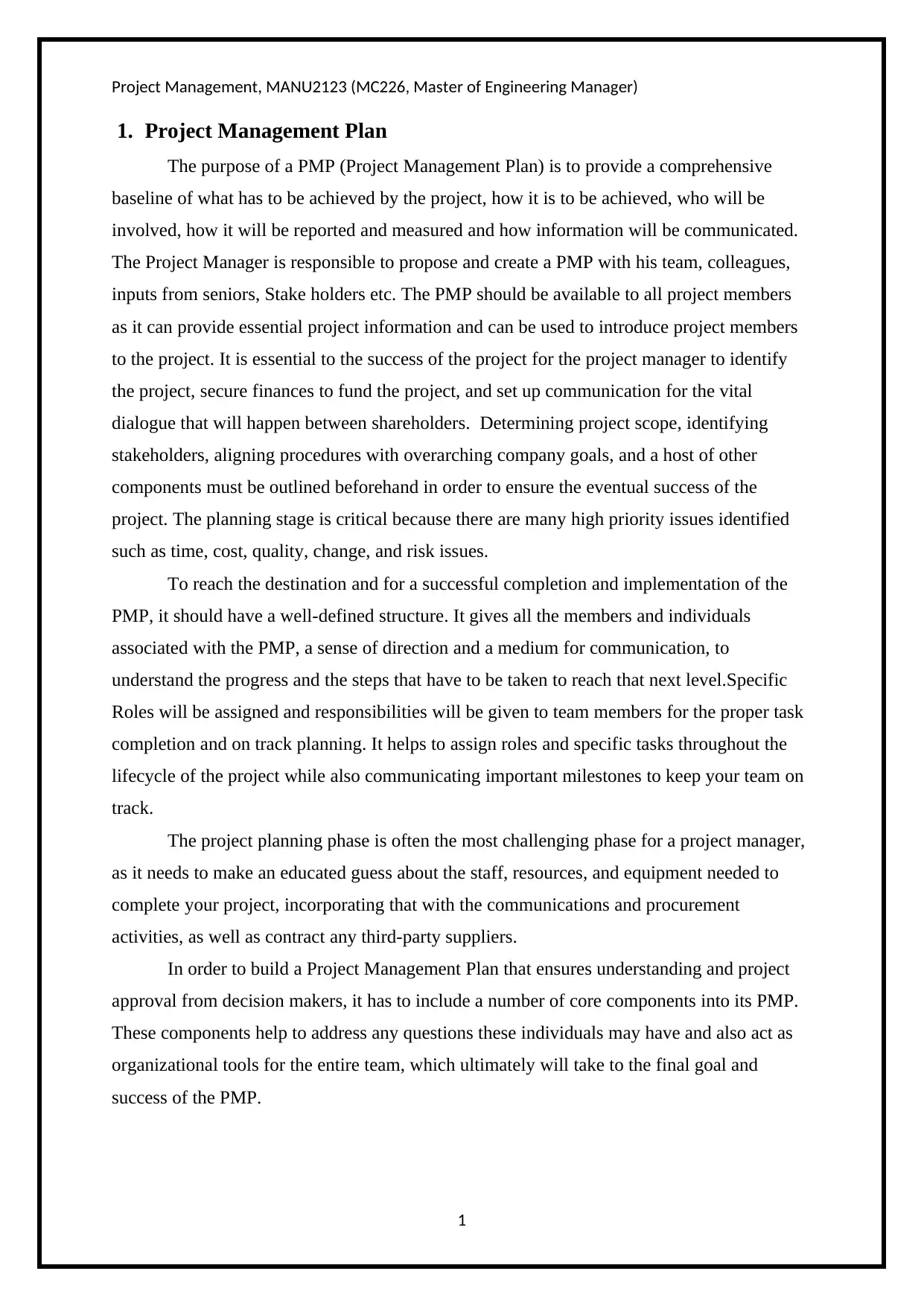
Project Management, MANU2123 (MC226, Master of Engineering Manager)
1. Project Management Plan
The purpose of a PMP (Project Management Plan) is to provide a comprehensive
baseline of what has to be achieved by the project, how it is to be achieved, who will be
involved, how it will be reported and measured and how information will be communicated.
The Project Manager is responsible to propose and create a PMP with his team, colleagues,
inputs from seniors, Stake holders etc. The PMP should be available to all project members
as it can provide essential project information and can be used to introduce project members
to the project. It is essential to the success of the project for the project manager to identify
the project, secure finances to fund the project, and set up communication for the vital
dialogue that will happen between shareholders. Determining project scope, identifying
stakeholders, aligning procedures with overarching company goals, and a host of other
components must be outlined beforehand in order to ensure the eventual success of the
project. The planning stage is critical because there are many high priority issues identified
such as time, cost, quality, change, and risk issues.
To reach the destination and for a successful completion and implementation of the
PMP, it should have a well-defined structure. It gives all the members and individuals
associated with the PMP, a sense of direction and a medium for communication, to
understand the progress and the steps that have to be taken to reach that next level.Specific
Roles will be assigned and responsibilities will be given to team members for the proper task
completion and on track planning. It helps to assign roles and specific tasks throughout the
lifecycle of the project while also communicating important milestones to keep your team on
track.
The project planning phase is often the most challenging phase for a project manager,
as it needs to make an educated guess about the staff, resources, and equipment needed to
complete your project, incorporating that with the communications and procurement
activities, as well as contract any third-party suppliers.
In order to build a Project Management Plan that ensures understanding and project
approval from decision makers, it has to include a number of core components into its PMP.
These components help to address any questions these individuals may have and also act as
organizational tools for the entire team, which ultimately will take to the final goal and
success of the PMP.
1
1. Project Management Plan
The purpose of a PMP (Project Management Plan) is to provide a comprehensive
baseline of what has to be achieved by the project, how it is to be achieved, who will be
involved, how it will be reported and measured and how information will be communicated.
The Project Manager is responsible to propose and create a PMP with his team, colleagues,
inputs from seniors, Stake holders etc. The PMP should be available to all project members
as it can provide essential project information and can be used to introduce project members
to the project. It is essential to the success of the project for the project manager to identify
the project, secure finances to fund the project, and set up communication for the vital
dialogue that will happen between shareholders. Determining project scope, identifying
stakeholders, aligning procedures with overarching company goals, and a host of other
components must be outlined beforehand in order to ensure the eventual success of the
project. The planning stage is critical because there are many high priority issues identified
such as time, cost, quality, change, and risk issues.
To reach the destination and for a successful completion and implementation of the
PMP, it should have a well-defined structure. It gives all the members and individuals
associated with the PMP, a sense of direction and a medium for communication, to
understand the progress and the steps that have to be taken to reach that next level.Specific
Roles will be assigned and responsibilities will be given to team members for the proper task
completion and on track planning. It helps to assign roles and specific tasks throughout the
lifecycle of the project while also communicating important milestones to keep your team on
track.
The project planning phase is often the most challenging phase for a project manager,
as it needs to make an educated guess about the staff, resources, and equipment needed to
complete your project, incorporating that with the communications and procurement
activities, as well as contract any third-party suppliers.
In order to build a Project Management Plan that ensures understanding and project
approval from decision makers, it has to include a number of core components into its PMP.
These components help to address any questions these individuals may have and also act as
organizational tools for the entire team, which ultimately will take to the final goal and
success of the PMP.
1
Paraphrase This Document
Need a fresh take? Get an instant paraphrase of this document with our AI Paraphraser
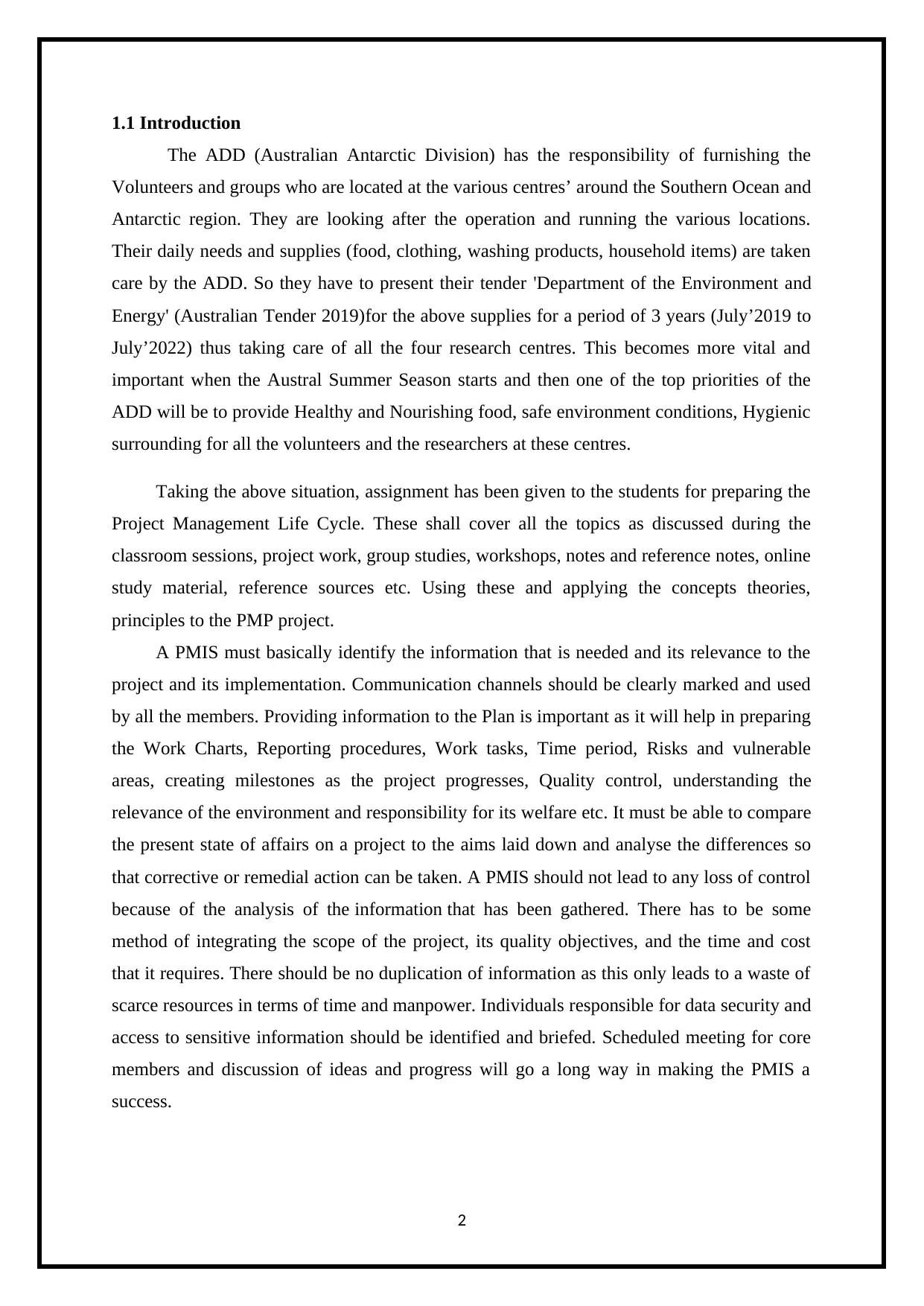
1.1 Introduction
The ADD (Australian Antarctic Division) has the responsibility of furnishing the
Volunteers and groups who are located at the various centres’ around the Southern Ocean and
Antarctic region. They are looking after the operation and running the various locations.
Their daily needs and supplies (food, clothing, washing products, household items) are taken
care by the ADD. So they have to present their tender 'Department of the Environment and
Energy' (Australian Tender 2019)for the above supplies for a period of 3 years (July’2019 to
July’2022) thus taking care of all the four research centres. This becomes more vital and
important when the Austral Summer Season starts and then one of the top priorities of the
ADD will be to provide Healthy and Nourishing food, safe environment conditions, Hygienic
surrounding for all the volunteers and the researchers at these centres.
Taking the above situation, assignment has been given to the students for preparing the
Project Management Life Cycle. These shall cover all the topics as discussed during the
classroom sessions, project work, group studies, workshops, notes and reference notes, online
study material, reference sources etc. Using these and applying the concepts theories,
principles to the PMP project.
A PMIS must basically identify the information that is needed and its relevance to the
project and its implementation. Communication channels should be clearly marked and used
by all the members. Providing information to the Plan is important as it will help in preparing
the Work Charts, Reporting procedures, Work tasks, Time period, Risks and vulnerable
areas, creating milestones as the project progresses, Quality control, understanding the
relevance of the environment and responsibility for its welfare etc. It must be able to compare
the present state of affairs on a project to the aims laid down and analyse the differences so
that corrective or remedial action can be taken. A PMIS should not lead to any loss of control
because of the analysis of the information that has been gathered. There has to be some
method of integrating the scope of the project, its quality objectives, and the time and cost
that it requires. There should be no duplication of information as this only leads to a waste of
scarce resources in terms of time and manpower. Individuals responsible for data security and
access to sensitive information should be identified and briefed. Scheduled meeting for core
members and discussion of ideas and progress will go a long way in making the PMIS a
success.
2
The ADD (Australian Antarctic Division) has the responsibility of furnishing the
Volunteers and groups who are located at the various centres’ around the Southern Ocean and
Antarctic region. They are looking after the operation and running the various locations.
Their daily needs and supplies (food, clothing, washing products, household items) are taken
care by the ADD. So they have to present their tender 'Department of the Environment and
Energy' (Australian Tender 2019)for the above supplies for a period of 3 years (July’2019 to
July’2022) thus taking care of all the four research centres. This becomes more vital and
important when the Austral Summer Season starts and then one of the top priorities of the
ADD will be to provide Healthy and Nourishing food, safe environment conditions, Hygienic
surrounding for all the volunteers and the researchers at these centres.
Taking the above situation, assignment has been given to the students for preparing the
Project Management Life Cycle. These shall cover all the topics as discussed during the
classroom sessions, project work, group studies, workshops, notes and reference notes, online
study material, reference sources etc. Using these and applying the concepts theories,
principles to the PMP project.
A PMIS must basically identify the information that is needed and its relevance to the
project and its implementation. Communication channels should be clearly marked and used
by all the members. Providing information to the Plan is important as it will help in preparing
the Work Charts, Reporting procedures, Work tasks, Time period, Risks and vulnerable
areas, creating milestones as the project progresses, Quality control, understanding the
relevance of the environment and responsibility for its welfare etc. It must be able to compare
the present state of affairs on a project to the aims laid down and analyse the differences so
that corrective or remedial action can be taken. A PMIS should not lead to any loss of control
because of the analysis of the information that has been gathered. There has to be some
method of integrating the scope of the project, its quality objectives, and the time and cost
that it requires. There should be no duplication of information as this only leads to a waste of
scarce resources in terms of time and manpower. Individuals responsible for data security and
access to sensitive information should be identified and briefed. Scheduled meeting for core
members and discussion of ideas and progress will go a long way in making the PMIS a
success.
2
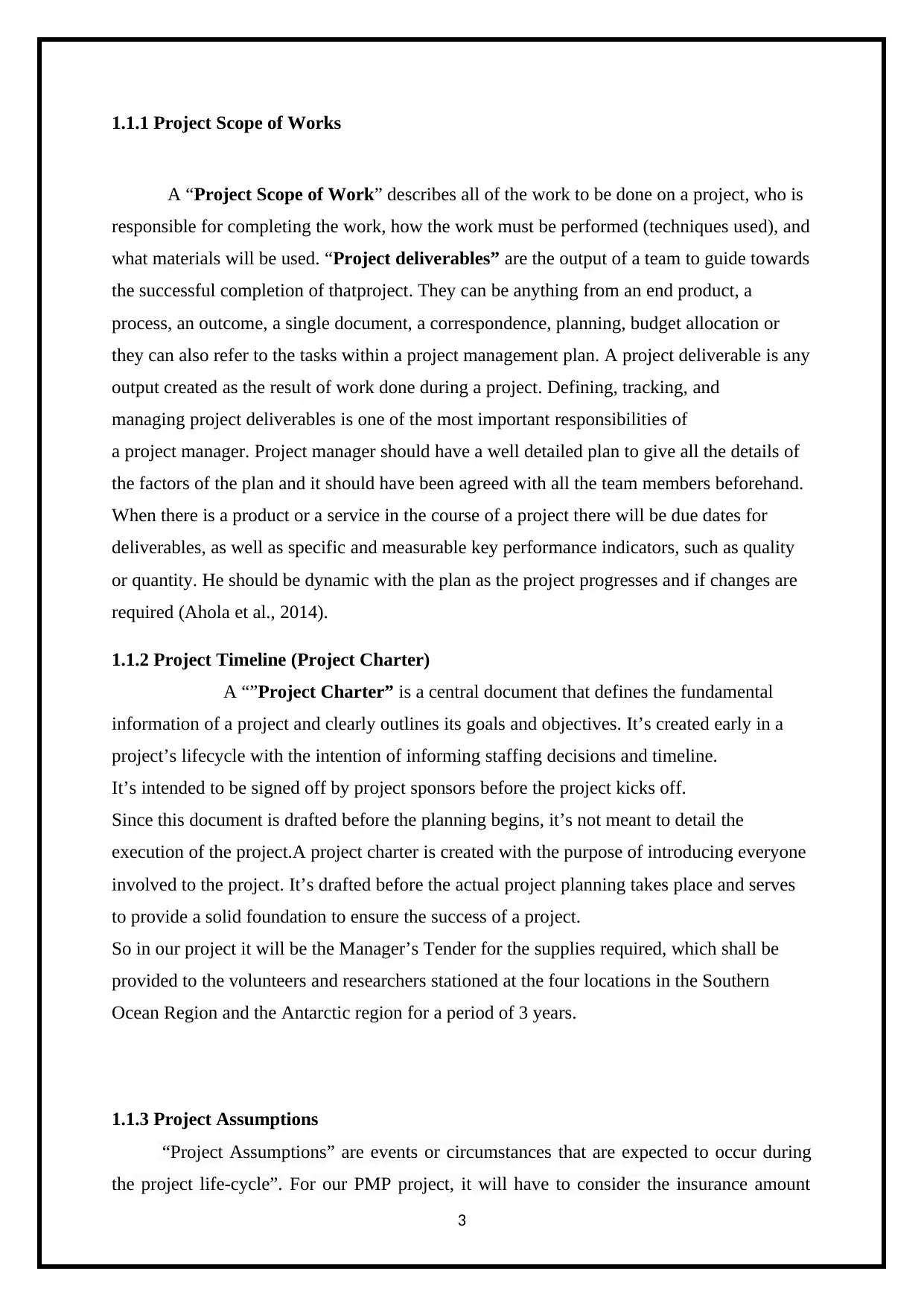
1.1.1 Project Scope of Works
A “Project Scope of Work” describes all of the work to be done on a project, who is
responsible for completing the work, how the work must be performed (techniques used), and
what materials will be used. “Project deliverables” are the output of a team to guide towards
the successful completion of thatproject. They can be anything from an end product, a
process, an outcome, a single document, a correspondence, planning, budget allocation or
they can also refer to the tasks within a project management plan. A project deliverable is any
output created as the result of work done during a project. Defining, tracking, and
managing project deliverables is one of the most important responsibilities of
a project manager. Project manager should have a well detailed plan to give all the details of
the factors of the plan and it should have been agreed with all the team members beforehand.
When there is a product or a service in the course of a project there will be due dates for
deliverables, as well as specific and measurable key performance indicators, such as quality
or quantity. He should be dynamic with the plan as the project progresses and if changes are
required (Ahola et al., 2014).
1.1.2 Project Timeline (Project Charter)
A “”Project Charter” is a central document that defines the fundamental
information of a project and clearly outlines its goals and objectives. It’s created early in a
project’s lifecycle with the intention of informing staffing decisions and timeline.
It’s intended to be signed off by project sponsors before the project kicks off.
Since this document is drafted before the planning begins, it’s not meant to detail the
execution of the project.A project charter is created with the purpose of introducing everyone
involved to the project. It’s drafted before the actual project planning takes place and serves
to provide a solid foundation to ensure the success of a project.
So in our project it will be the Manager’s Tender for the supplies required, which shall be
provided to the volunteers and researchers stationed at the four locations in the Southern
Ocean Region and the Antarctic region for a period of 3 years.
1.1.3 Project Assumptions
“Project Assumptions” are events or circumstances that are expected to occur during
the project life-cycle”. For our PMP project, it will have to consider the insurance amount
3
A “Project Scope of Work” describes all of the work to be done on a project, who is
responsible for completing the work, how the work must be performed (techniques used), and
what materials will be used. “Project deliverables” are the output of a team to guide towards
the successful completion of thatproject. They can be anything from an end product, a
process, an outcome, a single document, a correspondence, planning, budget allocation or
they can also refer to the tasks within a project management plan. A project deliverable is any
output created as the result of work done during a project. Defining, tracking, and
managing project deliverables is one of the most important responsibilities of
a project manager. Project manager should have a well detailed plan to give all the details of
the factors of the plan and it should have been agreed with all the team members beforehand.
When there is a product or a service in the course of a project there will be due dates for
deliverables, as well as specific and measurable key performance indicators, such as quality
or quantity. He should be dynamic with the plan as the project progresses and if changes are
required (Ahola et al., 2014).
1.1.2 Project Timeline (Project Charter)
A “”Project Charter” is a central document that defines the fundamental
information of a project and clearly outlines its goals and objectives. It’s created early in a
project’s lifecycle with the intention of informing staffing decisions and timeline.
It’s intended to be signed off by project sponsors before the project kicks off.
Since this document is drafted before the planning begins, it’s not meant to detail the
execution of the project.A project charter is created with the purpose of introducing everyone
involved to the project. It’s drafted before the actual project planning takes place and serves
to provide a solid foundation to ensure the success of a project.
So in our project it will be the Manager’s Tender for the supplies required, which shall be
provided to the volunteers and researchers stationed at the four locations in the Southern
Ocean Region and the Antarctic region for a period of 3 years.
1.1.3 Project Assumptions
“Project Assumptions” are events or circumstances that are expected to occur during
the project life-cycle”. For our PMP project, it will have to consider the insurance amount
3
⊘ This is a preview!⊘
Do you want full access?
Subscribe today to unlock all pages.

Trusted by 1+ million students worldwide

and liability in case of property damage, individual injury, and occurrence of death when the
supplies and the stores are being delivered. Now in our assignment, that insured amount has
been taken as USD 10 million/ occurrence and which shall not be less than USD 20 million in
aggregate (Cain, 2012).
1.1.4 Project Limitations
The Project has limitations like,
1) Proper temperature to be maintained for Food supplies, especially when being
transported.
2) Use of customized delivery vehicles and equipments to handle food.
3) Limitations of supplies, non-availability of certain Food items as required in the
tender.
4) Unpredictable Weather, Traffic, Delivery vehicle accidental breakdowns etc can
cause food supply delays.
1.2 Schedule (Time Management)
A “Time Management Schedule”, from the name itself, is a form of an
activity schedule designed to exercise control over the time period spent to carry out specific
activities. This type of schedule is a lot like a weekly schedule or a monthly schedule as
activities in a day are planned out wisely. Time management should involve the whole
project team, including the individual members and not just focus on the Project manager.
The project time management process is dynamic and may require input from several
different teams each with individual project time management process in order to integrate
the various interdependent component parts of the project to achieve the project
deliverable(s). The processes are recurrent within each work package of the project and occur
at least once within the project as a whole (Sigma Pi Sigma Chapter Project Award Winners,
2013).
1.3 Millstones
1.3.1 Project Review Process
The Project Review Process will be an analysis after the completion of each task of
the overall assignment and how it could have been done in a better way with the over all
progress and results of the Project (Lee and Yu, 2011). Post project reviews are a valuable
4
supplies and the stores are being delivered. Now in our assignment, that insured amount has
been taken as USD 10 million/ occurrence and which shall not be less than USD 20 million in
aggregate (Cain, 2012).
1.1.4 Project Limitations
The Project has limitations like,
1) Proper temperature to be maintained for Food supplies, especially when being
transported.
2) Use of customized delivery vehicles and equipments to handle food.
3) Limitations of supplies, non-availability of certain Food items as required in the
tender.
4) Unpredictable Weather, Traffic, Delivery vehicle accidental breakdowns etc can
cause food supply delays.
1.2 Schedule (Time Management)
A “Time Management Schedule”, from the name itself, is a form of an
activity schedule designed to exercise control over the time period spent to carry out specific
activities. This type of schedule is a lot like a weekly schedule or a monthly schedule as
activities in a day are planned out wisely. Time management should involve the whole
project team, including the individual members and not just focus on the Project manager.
The project time management process is dynamic and may require input from several
different teams each with individual project time management process in order to integrate
the various interdependent component parts of the project to achieve the project
deliverable(s). The processes are recurrent within each work package of the project and occur
at least once within the project as a whole (Sigma Pi Sigma Chapter Project Award Winners,
2013).
1.3 Millstones
1.3.1 Project Review Process
The Project Review Process will be an analysis after the completion of each task of
the overall assignment and how it could have been done in a better way with the over all
progress and results of the Project (Lee and Yu, 2011). Post project reviews are a valuable
4
Paraphrase This Document
Need a fresh take? Get an instant paraphrase of this document with our AI Paraphraser

way for teams to improve their performance and skills. It is important to get as many
stakeholders as possible in the review since it is helps to review all parts of the project as well
as provides a mechanism to clear up misunderstandings and other issues. It will give a picture
as to the project is progressing as it was pre-planned or is it deviating from it. Completing
reviews of important projects is very important and can identify high risk items early enough
to minimise the impact (Leybourne, Warburton and Kanabar, 2014). It will be well
documented and used as a reference tool for further in the use of the project assignment.
The Project Manager of the Assignment will conduct regular meeting and schedules for the
review of the project. He will discuss with every member of the team and will decide the next
step of the plan. Inputs and advice from all the members of the team and also from the
seniors/ higher authorities shall be taken before proceeding to the next phase/ plan of the
project. This shall lead to the succeeding steps and also for the smooth operation for the
remaining project (Dash, 2014).
1.3.2 Deliverables
As per the Budget given and the time period limit taken, a report will be prepared for
the tender proposal for supplying all the food, supplies, products etc.
1.4 Cost and Budget Management
The constraints of the Budget is very important and one of the key factors of
the whole project. This will include all the expenditures like Taxations, service cost,
employee salary, and cost of products and sundry costs that will go for the entire project
(Müller et al., 2013).
Cost and budget’s Project management is required.
1.5 Human Resource Management
Human resource management is the strategic approach to the effective management of
people in an organization so that they help the business to gain a competitive advantage
(Ljungblom and Lennerfors, 2018). It is designed to maximize employee performance in
service of an employer's strategic objectives. The key features of the Human Resource
Management will include,
5
stakeholders as possible in the review since it is helps to review all parts of the project as well
as provides a mechanism to clear up misunderstandings and other issues. It will give a picture
as to the project is progressing as it was pre-planned or is it deviating from it. Completing
reviews of important projects is very important and can identify high risk items early enough
to minimise the impact (Leybourne, Warburton and Kanabar, 2014). It will be well
documented and used as a reference tool for further in the use of the project assignment.
The Project Manager of the Assignment will conduct regular meeting and schedules for the
review of the project. He will discuss with every member of the team and will decide the next
step of the plan. Inputs and advice from all the members of the team and also from the
seniors/ higher authorities shall be taken before proceeding to the next phase/ plan of the
project. This shall lead to the succeeding steps and also for the smooth operation for the
remaining project (Dash, 2014).
1.3.2 Deliverables
As per the Budget given and the time period limit taken, a report will be prepared for
the tender proposal for supplying all the food, supplies, products etc.
1.4 Cost and Budget Management
The constraints of the Budget is very important and one of the key factors of
the whole project. This will include all the expenditures like Taxations, service cost,
employee salary, and cost of products and sundry costs that will go for the entire project
(Müller et al., 2013).
Cost and budget’s Project management is required.
1.5 Human Resource Management
Human resource management is the strategic approach to the effective management of
people in an organization so that they help the business to gain a competitive advantage
(Ljungblom and Lennerfors, 2018). It is designed to maximize employee performance in
service of an employer's strategic objectives. The key features of the Human Resource
Management will include,
5
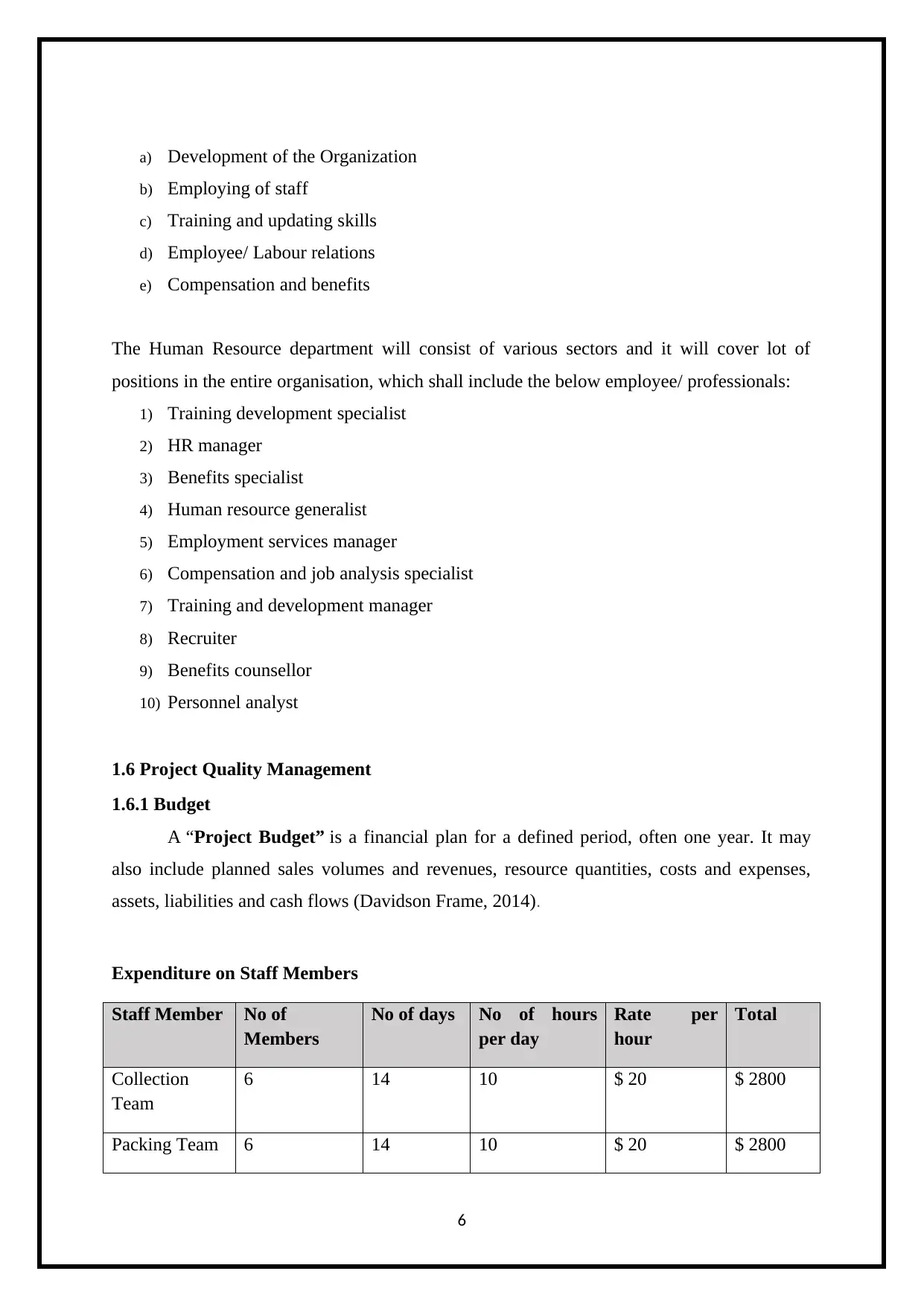
a) Development of the Organization
b) Employing of staff
c) Training and updating skills
d) Employee/ Labour relations
e) Compensation and benefits
The Human Resource department will consist of various sectors and it will cover lot of
positions in the entire organisation, which shall include the below employee/ professionals:
1) Training development specialist
2) HR manager
3) Benefits specialist
4) Human resource generalist
5) Employment services manager
6) Compensation and job analysis specialist
7) Training and development manager
8) Recruiter
9) Benefits counsellor
10) Personnel analyst
1.6 Project Quality Management
1.6.1 Budget
A “Project Budget” is a financial plan for a defined period, often one year. It may
also include planned sales volumes and revenues, resource quantities, costs and expenses,
assets, liabilities and cash flows (Davidson Frame, 2014).
Expenditure on Staff Members
Staff Member No of
Members
No of days No of hours
per day
Rate per
hour
Total
Collection
Team
6 14 10 $ 20 $ 2800
Packing Team 6 14 10 $ 20 $ 2800
6
b) Employing of staff
c) Training and updating skills
d) Employee/ Labour relations
e) Compensation and benefits
The Human Resource department will consist of various sectors and it will cover lot of
positions in the entire organisation, which shall include the below employee/ professionals:
1) Training development specialist
2) HR manager
3) Benefits specialist
4) Human resource generalist
5) Employment services manager
6) Compensation and job analysis specialist
7) Training and development manager
8) Recruiter
9) Benefits counsellor
10) Personnel analyst
1.6 Project Quality Management
1.6.1 Budget
A “Project Budget” is a financial plan for a defined period, often one year. It may
also include planned sales volumes and revenues, resource quantities, costs and expenses,
assets, liabilities and cash flows (Davidson Frame, 2014).
Expenditure on Staff Members
Staff Member No of
Members
No of days No of hours
per day
Rate per
hour
Total
Collection
Team
6 14 10 $ 20 $ 2800
Packing Team 6 14 10 $ 20 $ 2800
6
⊘ This is a preview!⊘
Do you want full access?
Subscribe today to unlock all pages.

Trusted by 1+ million students worldwide
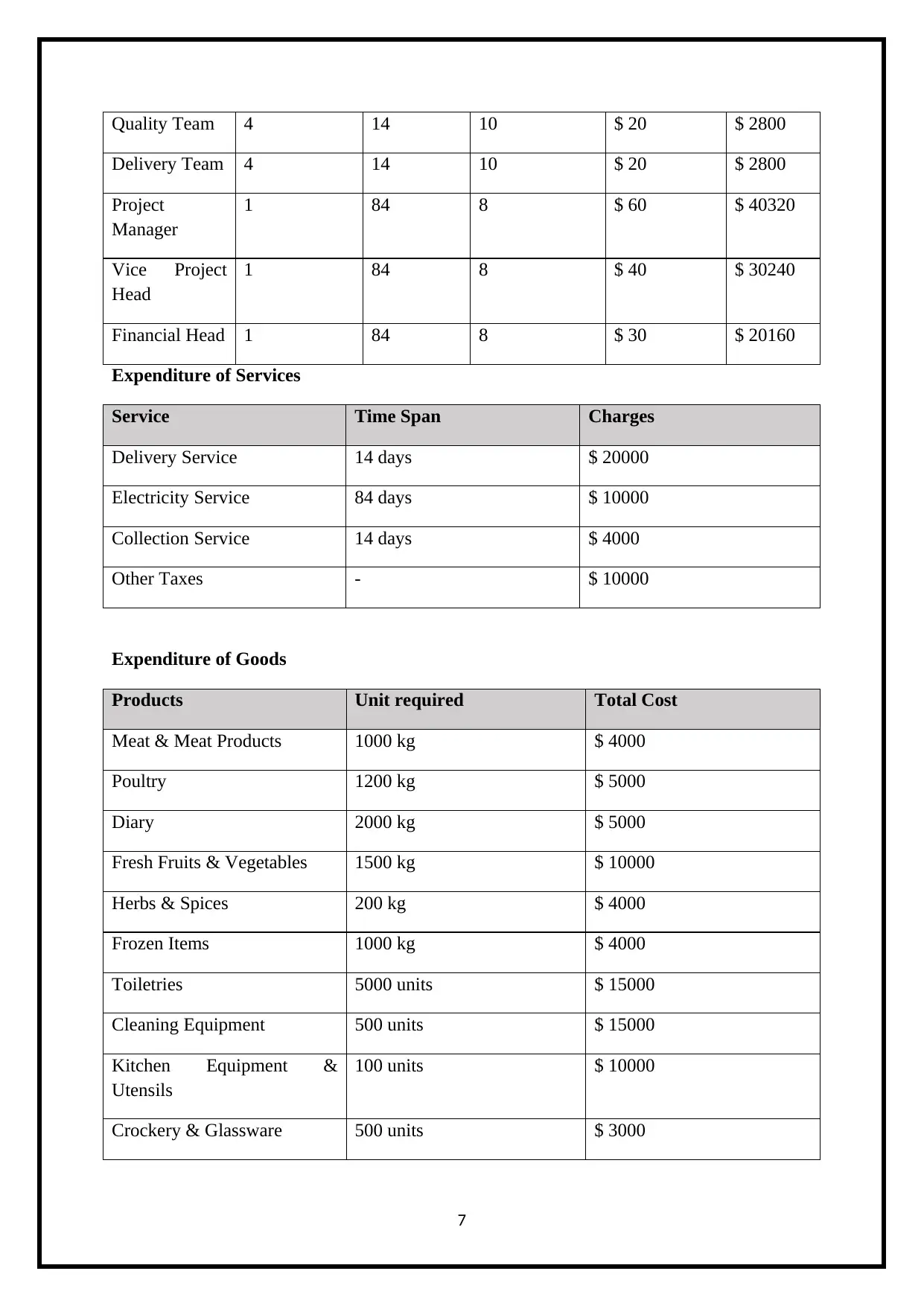
Quality Team 4 14 10 $ 20 $ 2800
Delivery Team 4 14 10 $ 20 $ 2800
Project
Manager
1 84 8 $ 60 $ 40320
Vice Project
Head
1 84 8 $ 40 $ 30240
Financial Head 1 84 8 $ 30 $ 20160
Expenditure of Services
Service Time Span Charges
Delivery Service 14 days $ 20000
Electricity Service 84 days $ 10000
Collection Service 14 days $ 4000
Other Taxes - $ 10000
Expenditure of Goods
Products Unit required Total Cost
Meat & Meat Products 1000 kg $ 4000
Poultry 1200 kg $ 5000
Diary 2000 kg $ 5000
Fresh Fruits & Vegetables 1500 kg $ 10000
Herbs & Spices 200 kg $ 4000
Frozen Items 1000 kg $ 4000
Toiletries 5000 units $ 15000
Cleaning Equipment 500 units $ 15000
Kitchen Equipment &
Utensils
100 units $ 10000
Crockery & Glassware 500 units $ 3000
7
Delivery Team 4 14 10 $ 20 $ 2800
Project
Manager
1 84 8 $ 60 $ 40320
Vice Project
Head
1 84 8 $ 40 $ 30240
Financial Head 1 84 8 $ 30 $ 20160
Expenditure of Services
Service Time Span Charges
Delivery Service 14 days $ 20000
Electricity Service 84 days $ 10000
Collection Service 14 days $ 4000
Other Taxes - $ 10000
Expenditure of Goods
Products Unit required Total Cost
Meat & Meat Products 1000 kg $ 4000
Poultry 1200 kg $ 5000
Diary 2000 kg $ 5000
Fresh Fruits & Vegetables 1500 kg $ 10000
Herbs & Spices 200 kg $ 4000
Frozen Items 1000 kg $ 4000
Toiletries 5000 units $ 15000
Cleaning Equipment 500 units $ 15000
Kitchen Equipment &
Utensils
100 units $ 10000
Crockery & Glassware 500 units $ 3000
7
Paraphrase This Document
Need a fresh take? Get an instant paraphrase of this document with our AI Paraphraser

1.6.2 Reporting
The “Reporting” should be an assessment that takes place during a project or process
that conveys details such as what sub-goals have been accomplished, what resources have
been expended, what problems have been encountered, and whether the project or process is
expected to be completed on time and within budget. It should give the overall picture of the
progress of the project and analyse the goals as set in the pre-planned discussion (Havenga
and Simpson, 2018).
1.6.3 Project Risks Management
“Project Risk Management”isan uncertain event or condition that, if it occurs, has a
positive or negative effect on a project’s objectives. It should be a dynamic process which
should take into account the factors that are constantly affecting the project. Same time is
should redevelop and regenerate itself. There should be risk calculation methods and steps to
minimize the same. Below is the procedure as to how to carry out the Risk Management,
Locate the Risk. Identify and uncover, recognize and describe the risks that might
affect the project and its outcomes.
Evaluate the risk. Once risks are identified, determine the likelihood and
consequence of each risk. Develop an understanding of the nature of the risk and its
potential to affect project goals and objectives
Prioritise the Risk. Evaluate or rank the risk by determining the risk magnitude,
which is the combination of likelihood and consequence. Take decisions about
whether the risk is acceptable or whether it is serious enough to warrant treatment.
Removal of the Risk. Called as Risk Response Planning, this step assessthe highest
ranked risks and set out a plan to treat or modify these risks to achieve acceptable risk
levels.
Track and Review the risk. This is the step where you take your Project Risk
Register and use it to monitor, track and review risks.
8
The “Reporting” should be an assessment that takes place during a project or process
that conveys details such as what sub-goals have been accomplished, what resources have
been expended, what problems have been encountered, and whether the project or process is
expected to be completed on time and within budget. It should give the overall picture of the
progress of the project and analyse the goals as set in the pre-planned discussion (Havenga
and Simpson, 2018).
1.6.3 Project Risks Management
“Project Risk Management”isan uncertain event or condition that, if it occurs, has a
positive or negative effect on a project’s objectives. It should be a dynamic process which
should take into account the factors that are constantly affecting the project. Same time is
should redevelop and regenerate itself. There should be risk calculation methods and steps to
minimize the same. Below is the procedure as to how to carry out the Risk Management,
Locate the Risk. Identify and uncover, recognize and describe the risks that might
affect the project and its outcomes.
Evaluate the risk. Once risks are identified, determine the likelihood and
consequence of each risk. Develop an understanding of the nature of the risk and its
potential to affect project goals and objectives
Prioritise the Risk. Evaluate or rank the risk by determining the risk magnitude,
which is the combination of likelihood and consequence. Take decisions about
whether the risk is acceptable or whether it is serious enough to warrant treatment.
Removal of the Risk. Called as Risk Response Planning, this step assessthe highest
ranked risks and set out a plan to treat or modify these risks to achieve acceptable risk
levels.
Track and Review the risk. This is the step where you take your Project Risk
Register and use it to monitor, track and review risks.
8

1.6.4 Communication Management
“Communications Management” is the systematic planning, implementing,
monitoring, and revision of all the channels of communication within an organization, and
between organizations; it also includes the organization and dissemination of
newcommunication directives connected with an organization, network or even a group. The
Communication Management Plan should have a detailed list and plan of the mode and track
of communication involved. These can be via emails, text, voice or even face to face
communication. Understanding and meeting the demands of the stake holders should be one
of the key factors of the communication plan (HTM-Praxis, 2013).
Now the various styles of Reports are as given below,
Status Report: Takes into account the present status and performance against the pre-
planned performance levels.
Progress Report: Total work that has been completed.
Trend Report:Whether performance has an upward trend or a downward trend is
reported by the trend report.
Forecasting Report:Future project status and performance is reported basis current (or
historical) data.
Variance Report:Compares actuals to baselines.
Earned Value Report:This report integrates scope, cost, and schedule measures to
assess project performance.
Lessons Learned Documentation:Performance reports are used as lessons learned for
future projects.
It’s the responsibility of the Project Manager to understand the communication lines and
modes of communication that will take place within the team members and the Stakeholders,
higher authorities etc for a smooth functioning of the project.
2. Review Process
The steps and process that makes up a Project Management Framework will include:
Initiation: - At the very start of the project.
Planning: - Appraisal,Managing and understanding the plan for the smooth
9
“Communications Management” is the systematic planning, implementing,
monitoring, and revision of all the channels of communication within an organization, and
between organizations; it also includes the organization and dissemination of
newcommunication directives connected with an organization, network or even a group. The
Communication Management Plan should have a detailed list and plan of the mode and track
of communication involved. These can be via emails, text, voice or even face to face
communication. Understanding and meeting the demands of the stake holders should be one
of the key factors of the communication plan (HTM-Praxis, 2013).
Now the various styles of Reports are as given below,
Status Report: Takes into account the present status and performance against the pre-
planned performance levels.
Progress Report: Total work that has been completed.
Trend Report:Whether performance has an upward trend or a downward trend is
reported by the trend report.
Forecasting Report:Future project status and performance is reported basis current (or
historical) data.
Variance Report:Compares actuals to baselines.
Earned Value Report:This report integrates scope, cost, and schedule measures to
assess project performance.
Lessons Learned Documentation:Performance reports are used as lessons learned for
future projects.
It’s the responsibility of the Project Manager to understand the communication lines and
modes of communication that will take place within the team members and the Stakeholders,
higher authorities etc for a smooth functioning of the project.
2. Review Process
The steps and process that makes up a Project Management Framework will include:
Initiation: - At the very start of the project.
Planning: - Appraisal,Managing and understanding the plan for the smooth
9
⊘ This is a preview!⊘
Do you want full access?
Subscribe today to unlock all pages.

Trusted by 1+ million students worldwide
1 out of 18
Related Documents
Your All-in-One AI-Powered Toolkit for Academic Success.
+13062052269
info@desklib.com
Available 24*7 on WhatsApp / Email
![[object Object]](/_next/static/media/star-bottom.7253800d.svg)
Unlock your academic potential
Copyright © 2020–2025 A2Z Services. All Rights Reserved. Developed and managed by ZUCOL.



